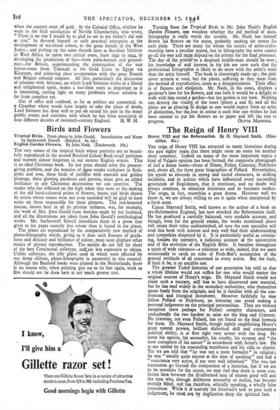Birds and Flowers
Tropical Birds. From plates by John Gould. Introduction and Notes by Sacheverell Sitwell. (Batsford. 6s. 6d.) English Garden Flowers. By John Nash. (Duckworth. 15s.)
THE very names of the tropical birds whose portraits are so beauti- fully reproduced in the second Batsford Colour Book recall perfumes and warmth almost forgotten in our austere English winter. This is an ideal Christmas book. Its low price should solve the present- giving problem, and the beauties of these tender cockatoos in flesh- pinks and rose, these birds of paradise with emerald and golden plumage, these glowing parakeets and parrots, must give an added brilliance to any Christmas decorations we can contrive. The reader who has reflected on the high talent that went to the making of the old hand-coloured prints of flowers, beasts and birds drawn by artists whose names were not even recorded will be glad to have notes on those responsible for these pictures. The red-breasted toucan, shown here in all its pristine richness, was, for example, the work of Mrs. John Gould from sketches made by her husband, and all the illustrations are taken from John Gould's ornithological works. Mr. Sacheverell Sitwell introduces them in a prose that gives to his pages scarcely less colour than is found in the plates.
The plates are reproduced by the comparatively new method of photo-lithography which, giving as it does such fineness of grada- tions and delicacy and brilliance of colour, must soon displace other means of picture reproduction. The results do not fall far short of the best Continental collotype, antt.are less expensive to obtain. Unlike collotype, the jelly plates used in which were affected by our damp climate, photo-lithography is successful in this country. Although the Batsford books were printed in the Netherlands, there is no reason why, when printing gets on to its feet again, work as fine should not be done here at not much greater cost.
Turning from the Tropical Birds to Mr. John Nash's English Garden Flowers, one wonders whether the old method of auto- lithography is really worth the trouble. Mr. Nash has himself drawn his flowers on the stone, probably making six stones for each plate. There are many for whom the results of artist-crafts- manship have a peculiar appeal, but in lithography the artist cannot go all the way and must depend on the printer for the final processes. The day of the printet-as a despised middle-man should be over ; his knowledge of and interest in his job are now such that the professional lithographer is likely to do more with the artist's work than the artist himself. The book is charmingly made up ; the pink cover attracts at once, but the plates, suffering as they must from the method of reproduction, come as a disappointment. Their effect is of flatness and etiolation. Mr. Nash, in his notes, displays a gardener's love for his flowers, and one feels it would be a delight to walk with him round a garden—but the garden is not here. Nothing can destroy the vitality of the roses (plates 4 and 8), and all the plates are as pleasing in design as one would expect from an artist of distinction, but the-loss in colour is such that one wishes he had been content to put his flowers on to paper and left the rest to


































 Previous page
Previous page